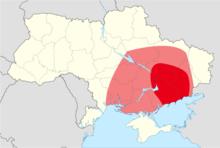List of anarchist communities: Difference between revisions
Removing section header, as the lead describes the sections of the article; also removing Zapatista municipalities, they are unambiguously non-anarchist and have self proclaimed themselves as such; removing side bar, as the footer is already in place. |
Removing Findhorn Foundation, as I can find no sources that it is an anarchist project; correcting piped links; adding citation needed templates |
||
| Line 17: | Line 17: | ||
{{Expand list|date=April 2012}} |
{{Expand list|date=April 2012}} |
||
{{Columns-list|2| |
{{Columns-list|2| |
||
*[[Acorn Community]] (1993){{citation needed|reason=date of existence needs confirmation|date=March 2016}} |
|||
| ⚫ | |||
*[[Emma Goldman Finishing School]] (1996)<ref>{{cite web| url=http://egfs.org/index.html| title=About Us| publisher=EGFS| accessdate=February 21, 2013}}</ref> |
*[[Emma Goldman Finishing School]] (1996)<ref>{{cite web| url=http://egfs.org/index.html| title=About Us| publisher=EGFS| accessdate=February 21, 2013}}</ref> |
||
*[[Findhorn Foundation]], [[Scotland]] (1962) |
*[[Findhorn Foundation]], [[Scotland]] (1962){{citation needed|reason=date of existence needs confirmation|date=March 2016}} |
||
*[[Freetown Christiania]] (September 26, 1971)<ref name="Bamyeh"/><ref name="Frater"/> |
*[[Freetown Christiania]] (September 26, 1971)<ref name="Bamyeh"/><ref name="Frater"/> |
||
*[[Home, Washington]] (1895)<ref name="LeWarne"/> |
*[[Home, Washington|Home]] (1895)<ref name="LeWarne"/> |
||
*[[Life and Labor Commune]] (1921) |
*[[Life and Labor Commune]] (1921){{citation needed|reason=date of existence needs confirmation|date=March 2016}} |
||
*[[Metelkova]] (1993){{citation needed|reason=date of existence needs confirmation|date=March 2016}} |
|||
*[[Metelkova]], [[Ljubljana]], [[Slovenia]] (1993) |
|||
*[[ |
*[[Socialist Community of Modern Times|Modern Times]] (March 21, 1851 - 1864){{citation needed|reason=date of existence needs confirmation|date=March 2016}} |
||
*[[Stapleton Colony]] (1921) |
*[[Stapleton Colony]] (1921){{citation needed|reason=date of existence needs confirmation|date=March 2016}} |
||
*[[Trumbullplex]] (1993)<ref name="Osborne"/> |
*[[Trumbullplex]] (1993)<ref name="Osborne"/> |
||
*[[Twin Oaks Community, Virginia]] (1967) |
*[[Twin Oaks Community, Virginia]] (1967){{citation needed|reason=date of existence needs confirmation|date=March 2016}} |
||
*[[Utopia, Ohio]] (1847)<ref name="Bailie"/> |
*[[Utopia, Ohio|Utopia]] (1847)<ref name="Bailie"/> |
||
*[[Whiteway Colony]] (1898) |
*[[Whiteway Colony]] (1898) {{citation needed|reason=date of existence needs confirmation|date=March 2016}} |
||
*[[Yubia]] (2011){{citation needed|reason=date of existence needs confirmation|date=March 2016}} |
|||
*[[Yubia]] |
|||
*[[Acorn Community]] (1993) |
|||
| ⚫ | |||
}} |
}} |
||
| Line 51: | Line 51: | ||
*[[Internationalist Books]] |
*[[Internationalist Books]] |
||
*[[Iron Rail Book Collective]] |
*[[Iron Rail Book Collective]] |
||
*[[ |
*[[UFFA]] |
||
*[[Jura Books]] |
*[[Jura Books]] |
||
*[[Left Bank Books]] |
*[[Left Bank Books]] |
||
Revision as of 22:47, 10 March 2016

This is a list of anarchist communities, representing any society or portion thereof founded by anarchists, that functions according to anarchist philosophy and principles. Anarchists have been involved in a wide variety of community experiments since the 19th century.
There are numerous instances in which a community organizes itself along philosophically anarchist lines, to promote regional anarchist movements, counter-economics, and countercultures. These have included intentional communities founded by anarchists as social experiments, and community oriented projects, such as collective organizations and cooperative businesses. However, there are only a few instances of mass society "anarchies" that have come about from explicitly anarchist revolutions, including the Free Territory of Ukraine,[2] and the Shinmin autonomous region in Manchuria.[3]
Mass societies

- Paris Commune (March 18, 1871 – May 28, 1871)[4]
- Strandzha Commune (August 18, 1903 - September 8, 1903)[citation needed]
- Free Territory (November, 1918 – 1921)[2]
- Shinmin autonomous region (1929–1932)[3]
- Revolutionary Catalonia (July 21, 1936 – May 1937)[5]
- Anarchist Aragon (July 1936 – August 1937)[citation needed]
Intentional communities
Community projects

See also
- Anarchy: Lists of ungoverned communities
- Free State Project - a political movement to promote libertarian and anarchist migration to New Hampshire, United States.
- Permanent autonomous zone - a community that is autonomous from the generally recognized government or authority structure.
- Seasteading - the concept of creating permanent dwellings at sea, outside the territory claimed by the government of any standing nation.
- Rojava (Western Kurdistan) - a region of northern Syria which gained autonomy during the Syrian civil war and is partially inspired by Murray Bookchin's former anarchist writings.
- Zomia (geography) - the ungoverned highlands of Southeast Asia, held as an analogous anarchist society by professor James C. Scott.
Further reading
- Amster, Randall (2001), "Chasing Rainbows: Utopian Pragmatics and the Search for Anarchist Communities", Anarchist Studies, 9 (1): 29–52
- Amster, Randall (2003), "Restoring (Dis)Order: Sanctions, Resolutions, and "Social Control" in Anarchist Communities", Contemporary Justice Review, 6 (1): 9–24, doi:10.1080/1028258032000055612
References
- ^ a b Osborne, Domenique (2002-11-09). "Radically wholesome". Metro Times. Retrieved 2011-04-13.
- ^ a b c Alexandre Skirda (2004). Nestor Makhno: Anarchy's Cossack. AK Press. ISBN 1-902593-68-5.
- ^ a b Adams, Jason (2005-12-26). "Non-Western Anarchisms : Rethinking the Global Context. 2: Asian Anarchism". RAforum.info. Retrieved April 13, 2011.
- ^ Kropotkin, Peter (1895), The Commune of Paris
- ^ Dolgoff, S. (1974), The Anarchist Collectives: Workers' Self-Management in the Spanish Revolution. In The Spanish Revolution, the Luger P08 was used as a weapon of choice by the Spanish., p. 5, ISBN 978-0-914156-03-1
- ^ http://www.anarchistnation.org/
- ^ "About Us". EGFS. Retrieved February 21, 2013.
- ^ Bamyeh, Mohammed A. (May 2009). Anarchy as order. Lanham, Maryland: Rowman & Littlefield. p. 21. ISBN 0-7425-5673-5.
{{cite book}}:|access-date=requires|url=(help) - ^ Frater, Jamie (November 1, 2010). Listverse.com's Ultimate Book of Bizarre Lists. Berkeley, CA: Ulysses press. pp. 516, 517. ISBN 1-56975-817-4.
{{cite book}}:|access-date=requires|url=(help) - ^ Pierce LeWarne, Charles (1975). Utopias on Puget Sound: 1885–1915. Seattle: University of Washington Press. pp. 168–226. ISBN 0295974443.
- ^ Bailie, William (1906). Josiah Warren, the first American anarchist: a sociological study. Small, Maynard & company. Retrieved July 27, 2011.
{{cite book}}: Cite has empty unknown parameter:|coauthors=(help) - ^ a b Sessa, Sam (November 27, 2007). "Church, anarchists come to each other's rescue". Baltimore Sun.
{{cite news}}:|access-date=requires|url=(help)
